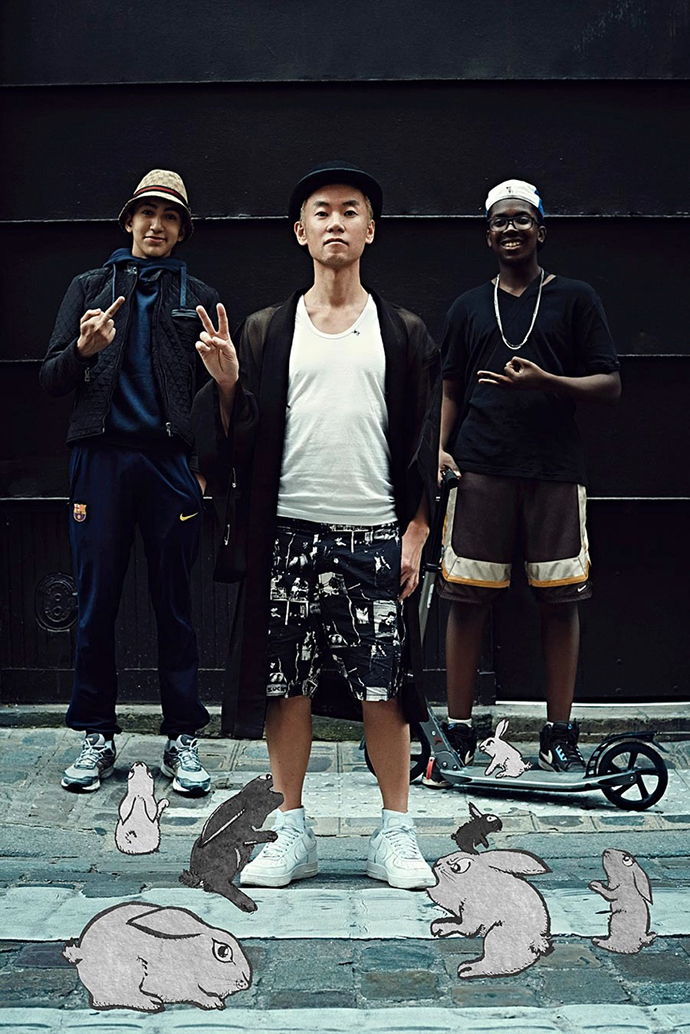-
paris is dead – THE 7 RABBIT LIVES OF MR. KAWAHARA
-IT STARTED THE MOMENT HE LANDED.
ON THE CHARLES DE GAULLE RUNWAY, WHITE RABBITS.
FROM THAT PRECISE MOMENT ON, SHINSUKE KAWAHARA’S OBSESSION WAS SET IN MOTION.
Conducted by Antoine Asseraf, René Habermacher, and Suzanne von Aichinger.
Transcribed and edited by Edward Siddons.
Photography by René Habermacher.
Illustration by Shinsuke Kawahara.
Creative direction by Antoine Asseraf.read more on PARISISDEAD.COM
00 -

Merry Xmas, Mister Sakamoto.
-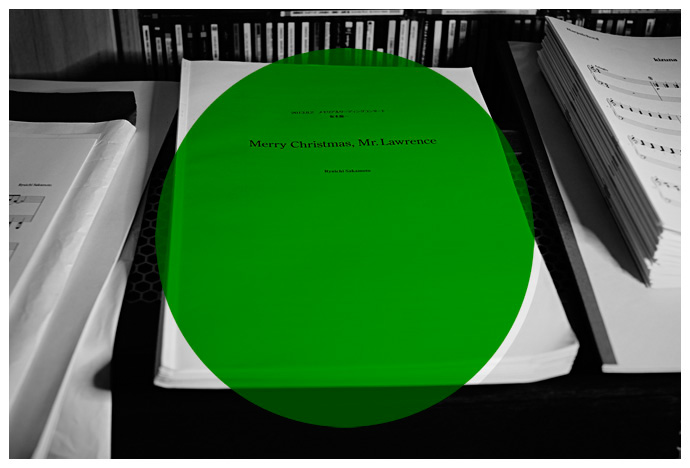 Manuscript to the score of "Furyo" by Ryuichi Sakamoto. Photography René Habermacher.
Manuscript to the score of "Furyo" by Ryuichi Sakamoto. Photography René Habermacher.It doesn’t quite add up.
There are the many facets of Ryuichi Sakamoto, but putting them together, you still wouldn’t get a sense of who the man is.
He is both an icon of Japan’s 1980’s Bubble Era, and the one who moved beyond Japan and away from the spotlight, a consistent experimentalist and accidental sex-symbol.
Founding member of the influential band Yellow Magic Orchestra, Japan’s answer to Kraftwerk.
Musical innovator for over 30 years, mixing synthpop, Okinawan traditions, sampling, bossa nova….
Screen-mate of David Bowie in the cult film “Merry Christmas, Mr. Lawrence” / “Furyo.”
Film composer for Almodovar, Oshima, Bertolucci, Oliver Stone and Brian de Palma.
Collaborating with David Byrne, Brian Wilson, Youssou N’Dour and the Dalai Lama.
Appearing in Madonna’s “Rain” music video.
Sampled by Afrika Bambaataa…and Mariah Carey.And last but not least, well before the Fukushima accident, a prominent activist in Japan’s anti-nuclear effort.
It doesn’t quite add up, and that’s really for the best, as we found out after spending an afternoon with him in New York City
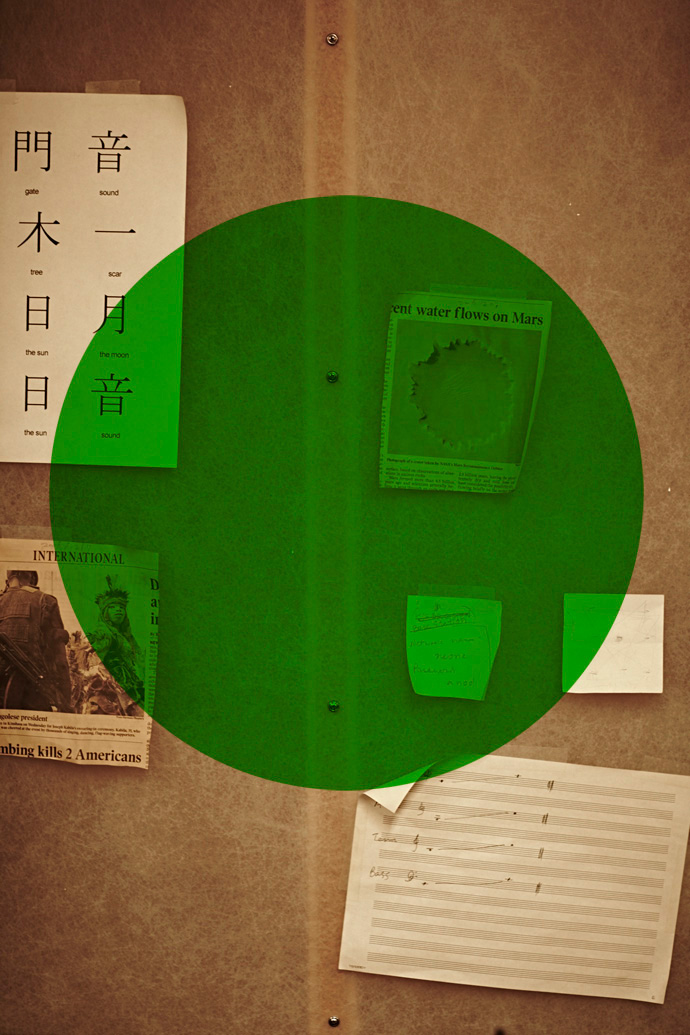
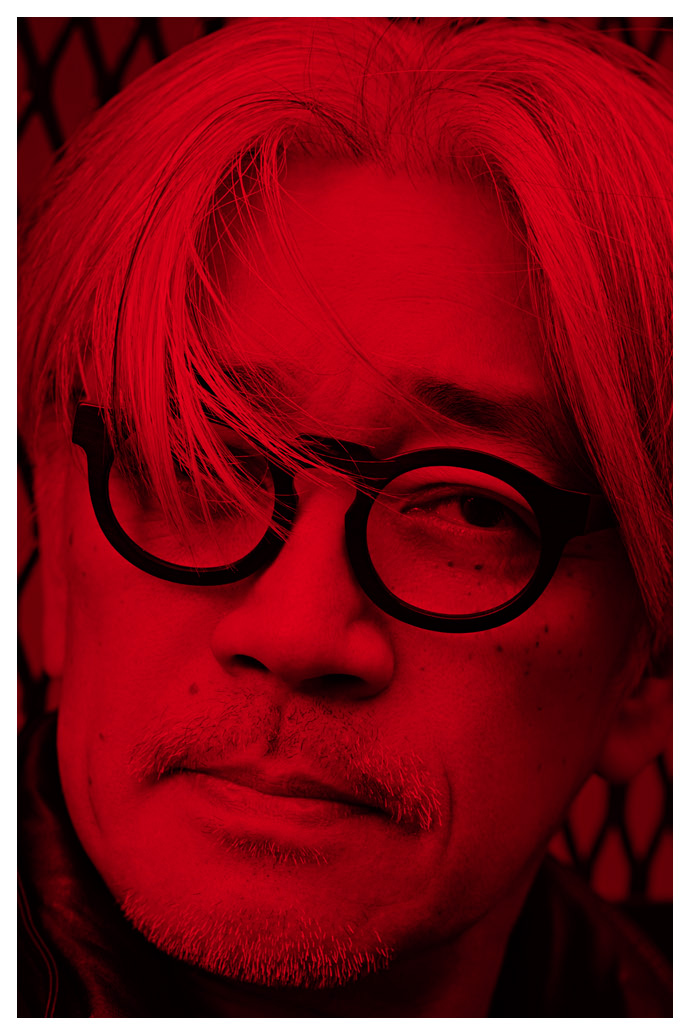 Left: inspiration board. Right: Ryuichi Sakamoto. Photography by René Habermacher.
Left: inspiration board. Right: Ryuichi Sakamoto. Photography by René Habermacher.The Stimuleye: When did you first feel personally concerned with the nuclear issue?
Ryuchi Sakamoto: Probably I started feeling anxious about it around the time of Chernobyl. Then I encountered the facts about the nuclear reprocessing plant in the northern part of Japan called Rokkasho. It was 7 years ago, pretty recent.
It’s not a usual nuclear plant, it’s to re-use, re-process used radioactive wastes. Through the processing, you emit hundreds of time more radioactive materials than the usual nuclear plant does. You get 365 nuclear plants in 1 village. Very dangerous.
So I started a web campaign, called Stop Rokkasho, I asked Kraftwerk to give us a sound logo, and they did actually ! The pretty famous graphic designer Jonathan Barnbrook had his assistant design the webpage, which was very neat.
As a web campaign it succeeded, my friends – photographers, musicians, stylists, creative people got to know about this plant. We decided to make a Stop Rokkasho tshirt, we asked more than 50 designers to make a tshirt. They needed phrases, so I gave them “No Nukes. More Trees.”
Everybody loved it, especially the second line.
It’s very easy to understand, and no one can resist.So, I decided to form a company called “More Trees”, it’s been 6 years, and we’ve been doing mainly conservation of Japanese forests. We have now 11 forests in Japan and 1 in Philippines.
(more…) -

undercover (and inside out)
-Japanese designer Jun Takahashi, the creative force behind the cult label Undercover has been a major influence in Japan’s fashion scene for more than a decade.
After vanishing for two years from the Parisian catwalk, he returned with a vengeance and presented his new collection to an audience that awaited his return, with mix of patience and restlessness.
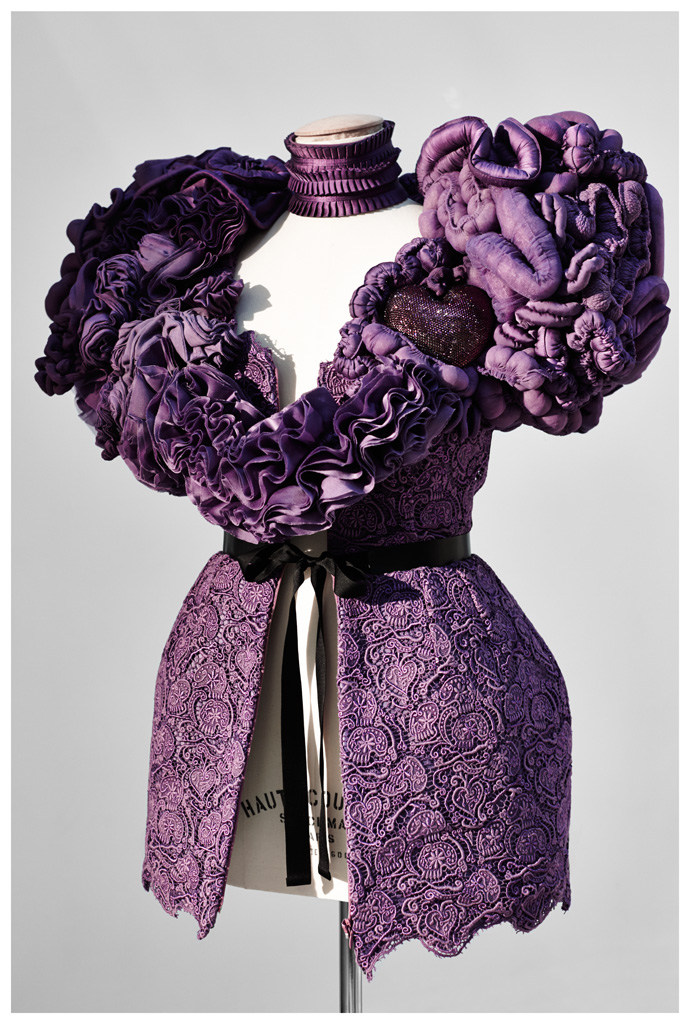
Inside out: Undercover dress with entrails, bone and skull lace, a heart on the right spot for the scary cute. Photo by René Habermacher.
The show at the intimate venue of the Institute Pasteur started with much delay, yet the undercover flock of disciples, among them the devoted Grace Coddington, awaited patiently what was to come from behind the antique glass-panelled doors: scary kittens with bunny masks on ponytailed shoes, wearing their insides out, ribcages and organs on outer display. Skeletal hands grasping waist lines, vintage lingerie elaborately piled-on to sleeveless evening jackets. Little dresses with what seemed to be ruffles at first glance, turned to be a romantic interpretation of entrails slung around the décolleté and a sparkling crystal studded heart.
Surprising,- or in the case of Jun Takahashi actually not- the arch from the drama of the unique pieces to the extremely wearable parts of the collection: googly eyes on a waxed trench coat, or the return of Undercover’s signature pieces, the perfecto, and the trench, with double collar and worn as a dress.
This is where the strength of Jun’s subversive vision lays: there is no friction between the everyday pieces and the elaborate constructed parts of his universe. Seamlessly he migrates between outfitter to the urban hipster to action art performer creating his giant Grace dolls from vintage plush toys in front of a bedazzled audience. The Graces, creatures from outer space were originally created for the presentation of the Undercover collection SS09 became somewhat of the labels mascot.
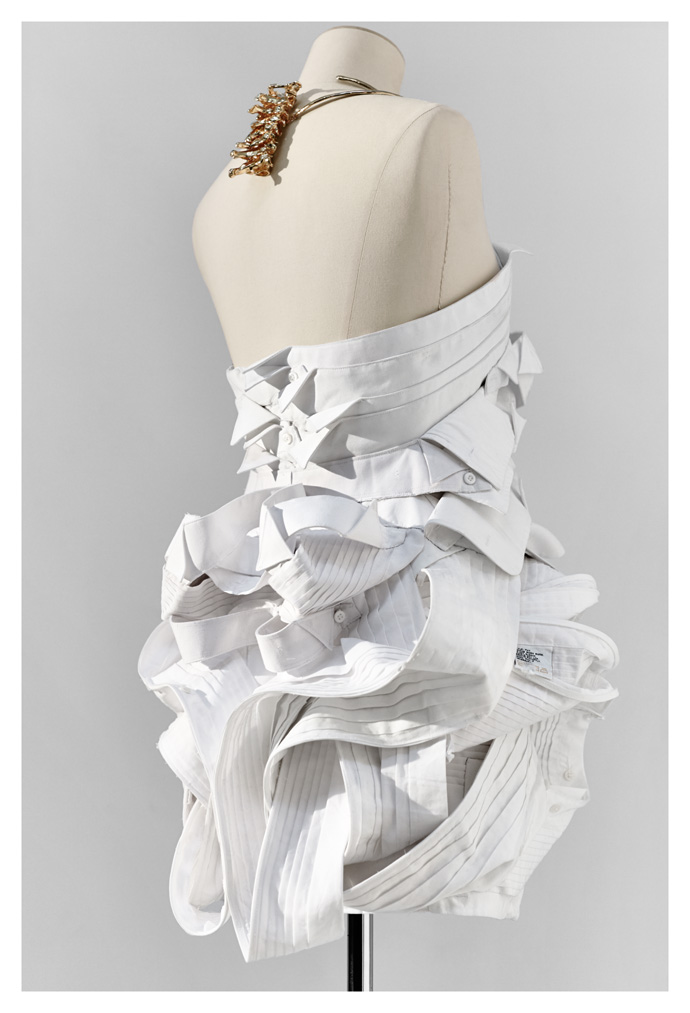
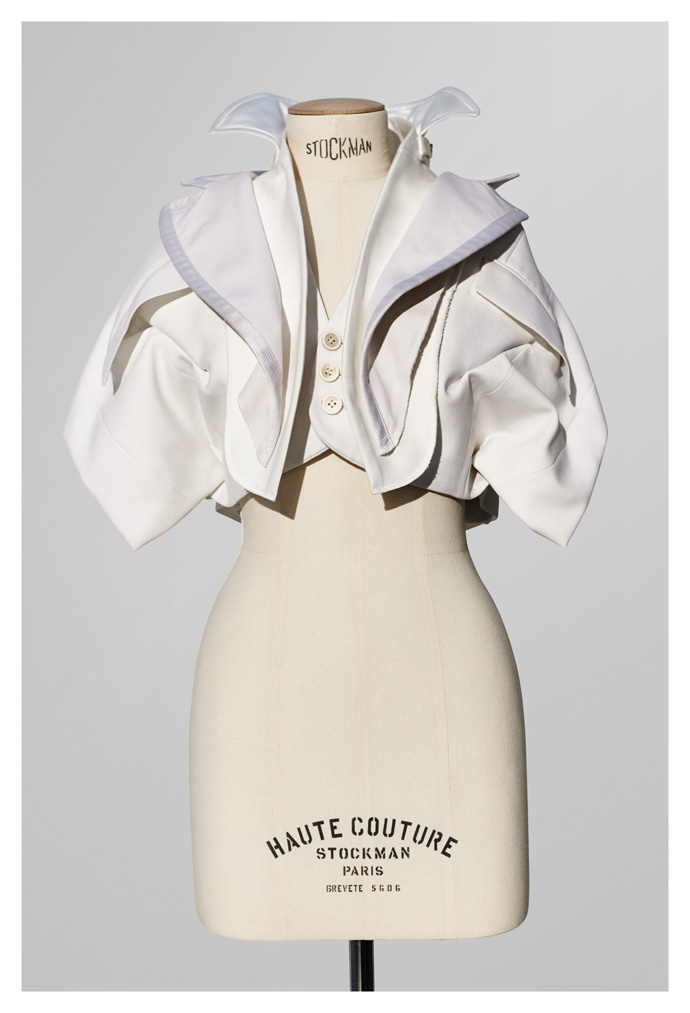
Starch undercover: special pieces made from deconstructed men's white shirt collars. Photo by René Habermacher.
René Habermacher: How is it to be back in Paris?
Jun Takahashi: It’s very exciting! Its been two years since we had the last show, so I am so happy!
You received well deserved great critics for this show of return.
how did you start with this collection, and how did it evolve and what is the narration?Last season when we came back to paris having just the showroom, I made seven special crafted pieces. It’s been a while since I’ve made such a creation and enjoyed it a lot.
It was just for the showroom, but this season i wanted to present a collection on the runway to show it to a broader audience. That’s how I started this collection.
The theme of the collection is about internal organs and bones, showing something from the inside exposed to the outside. Like lingerie that is usually hidden underneath, I used to make dresses and so expose them to the outside. That’s kind of the theme of the collection.Why did you decide at this moment to take the inside to outside?
I don’t know why (laughs). It’s been a while I wanted to show the “inside”. This is very undercover. It’s easy to express “Undercover”.
The motifs of organs and bones have something grotesque and scary in peoples minds. I take this and make it cute. It’s about both sides: not just scary, not just cute. we have both sides in the brand.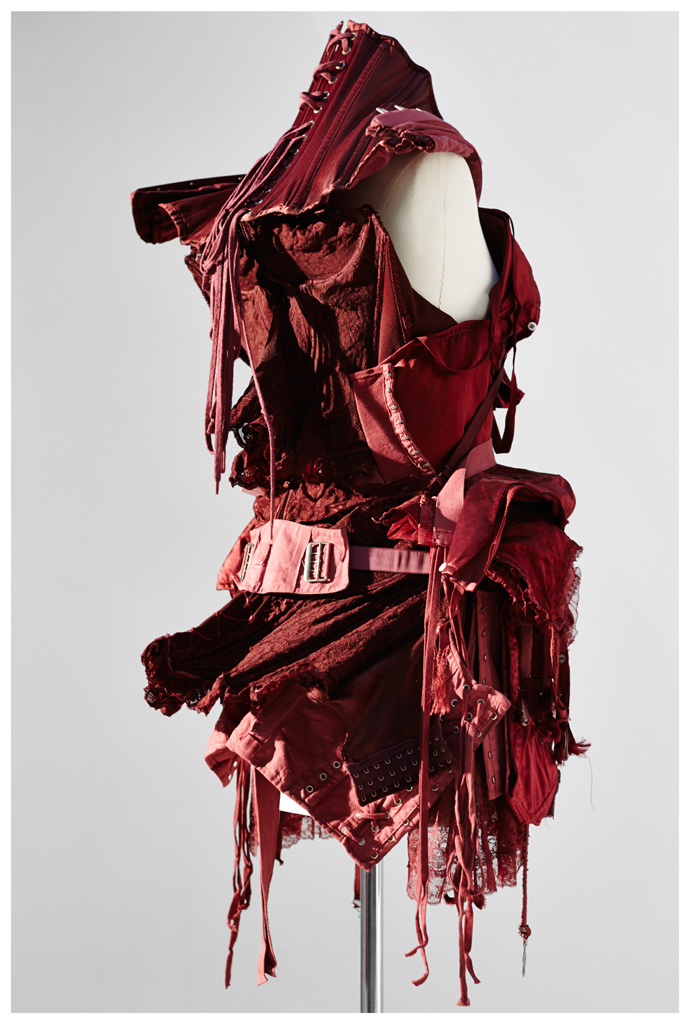
Pile-on vintage lingerie evening jacket. Photo by René Habermacher.
Are you a story teller?
(laughs) To me show is one big story, one drama, one stage. In a way I am not just making clothes, but one big tale, a story.
Since I was little I preferred the scary stories. I like Hitchcock movies. I am not necessarily into the ghostly but prefer the mental story.Another aspect is a strong sense of subculture evident in your work.
It is very different today then when you started off. What is subculture for you today?Most of he people surrounding me in Tokyo come from subculture, its a normal thing for me – its music, movies etc. not the mainstream. People in subculture are not specifically specialized in something – they don’t have mass-apeal. I like that. I source from this and then present my version in the “mass-area” like Paris.
Do you think exposure is dangerous for subculture?
The dark side of sub-culture! (laughs)
I take this positive. We always want to have information very quick- and I find this bloggers taking snapshots in the street very interesting, it’s really like I use the internet. How quick they are, it’s impossible for the print to catch up. Myself I like to post on Facebook and use the internet as a communication tool.Is the “season” still relevant to you?
When I design i don’t really think of the season. But when it comes to selling, we have to take this into consideration. For example in Japan we start selling FW collection in July, which is very difficult to sell Winter clothes because its still very hot for another 3 months until October. So we have to think about the balance between the creation and the business. So that’s difficult. We cannot completely ignore the seasons but not only thinking about seasons.
The runway shows’ timing are getting earlier and earlier and it takes time to actually get in the store.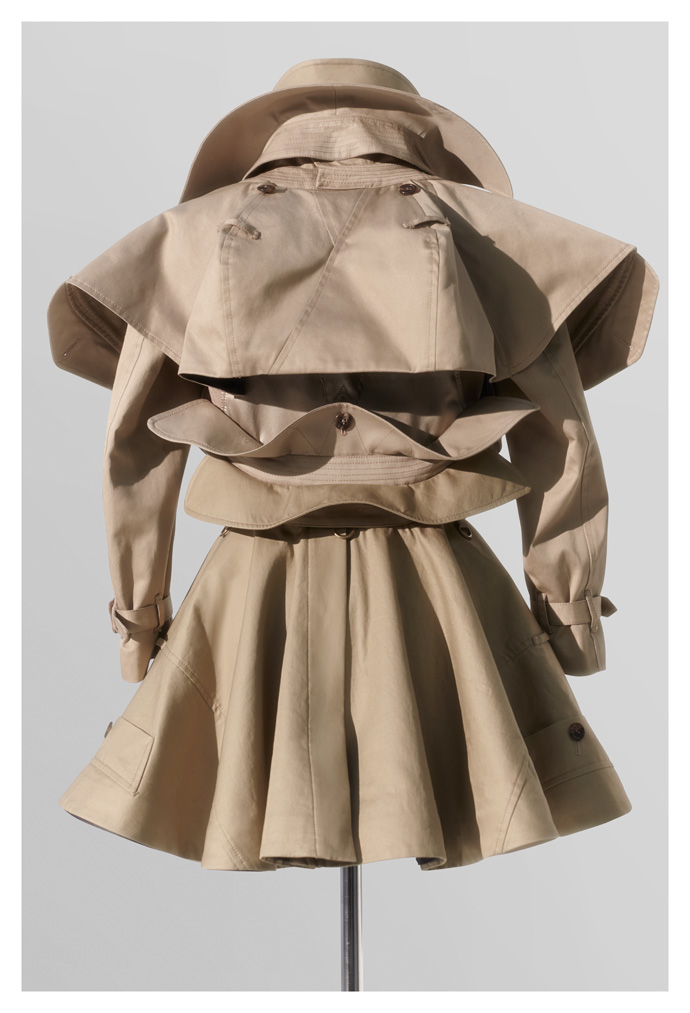
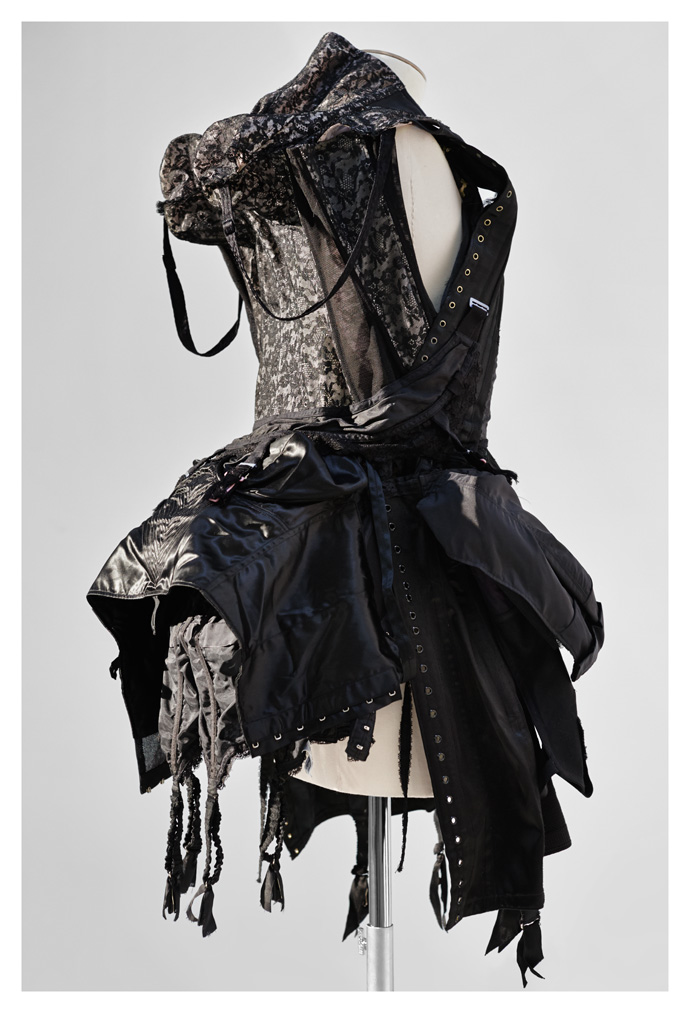
Undercover signature: the trench. Right: Pile-on vintage lingerie evening jacket. Photo by René Habermacher.
How is Japan to you today with the changes the country had been affected with the tsunami and the Fukushima incident especially?
Since the disaster was such a big thing and with the economical situation everybody’s feeling was like “hit the bottom.” We cannot be worse anymore. But now the people are actually trying to go up to be positive, they step back and reflect what can we do to recover from such a disaster. Maybe the government is not helping us that much, but people are trying to do something themselves, try to get the economy back and be positive.
How do you imagine the future your kids are growing up into?
They are little kids right now, but they are starting to have their own will where they wanna go. I am not so worried about them because they will find a way by themselves. We’re concerned about the future and the nuclear problem in fukushima, the earthquakes and what kind of effect this will have on us, but my kids will find their own way so I am not too much worried.
Are you still telling your kids stories of Grace? How is Grace, will we hear again from your creature?
I will continue with Grace- but Grace is not for little kids. They get a little scared… with one eye and all that.
I have a Grace doll in my house but at the beginning the kids were a little scared.But if you were a kid you would not be scared…
It’s scary – but there is an attraction too!
What’s next?
Showing the next collection in Paris again!
What is the last thing that stimulated you?
So many various things! conversations with friends – it’s not just one – it’s many different things.
I absorb everything. Family and friends are important. It’s important to have close friends that are straightforward in their opinion what they think about me, instead of just hiding things. It’s important to me to listen to them. A lot of my friends are creators, photographers doing their own thing. Their opinion is very important to me.
As I get older I get inspired and stimulated by more and more things. I can accept anything like a bus ticket.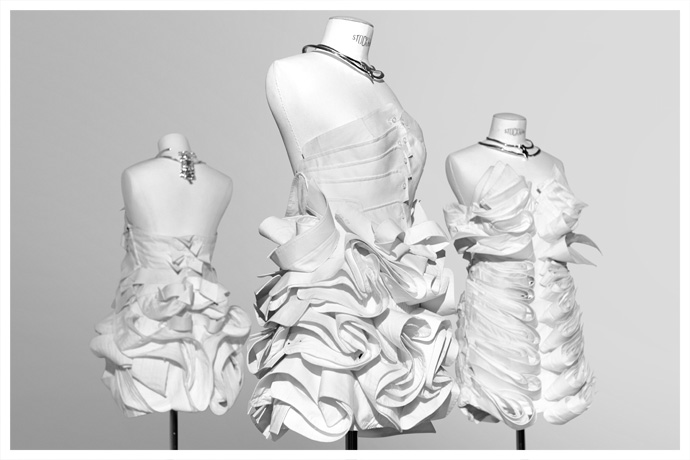
Trilogy in white starch: dresses from deconstructed men's white shirt collars. Photo by René Habermacher.
http://www.undercoverism.com
-

film of the season: Shangri-La
-The Stimuleye is proud to announce another collaboration with Kiko Mizuhara for Vivienne Tam Fall/Winter 2012/13.
Shot in temples in Kyoto, here is Shangri-La.
SHANGRI LA
a film by Antoine Asseraf
for Vivienne Tam Fall Winter 2012/13
starring Kiko Mizuharamusic Ça Va Chéri
postproduction Clast
assistant Jack
creative direction Hatsumi Yamada
production Hiromi Otsuka -

editor MASANOBU SUGATSUKE : An edit of an edit
-Masanobu Sugatsuke is one of the most influential editors, publisher of magazines such as COMPOSITE, INVITATION or METRO MIN in his native Japan, and of books with Mark Borthwick, Elizabeth Peyton or Jeff Burton. Masa considers himself not exactly a trendy person, yet is always on a forward trail, much ahead of his time.
THE STIMULEYE talked with Masa on the outlook of publishing and the editors future role, but also his recent book EDITORIAL PARADISE in which he is looking on his past editorial work. A reflection in a radical manner, rarely dared by others of his guild.
An edit of an edit, a compilation of compilations?
He’d been advised by a fellow columnist that “When an editor enters the spotlight, he automatically announces that it is time for him to go” he was told, as well as “an expression reaches a deadlock the moment it becomes self-referential”.“But wait a minute,” he writes in his foreword, “Godard and Truffaut initiated the Nouvelle Vague with their filmic reflections on film; contemporary art has developed as a form of “Art reviewing art”, and Rei Kawakubo and Martin Margiela keep proposing dresses that inspire the wearers to think about dressing. Could it be that there exists a whole different level that self-expression can only reach after going through the painful stage of self-reference?”
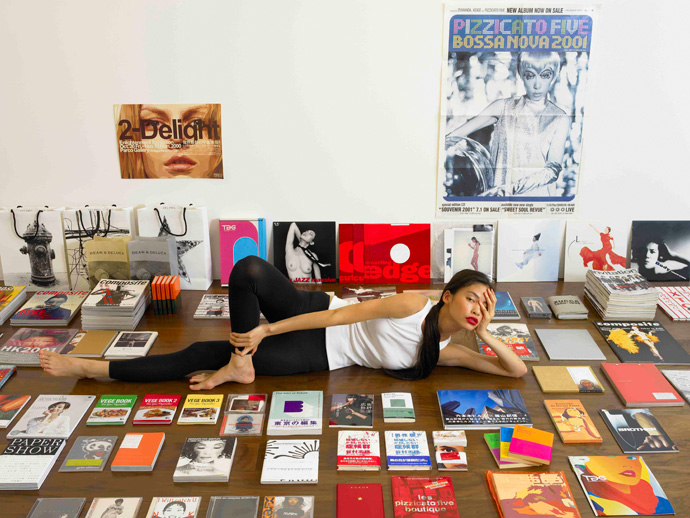 Works of Masanobu Sugatsuke laid out for EDITORIAL PARADISE.
Works of Masanobu Sugatsuke laid out for EDITORIAL PARADISE.When i visited you at you last time in Tokyo at your office – we had not seen each other for quite a long time.
Meanwhile you had halted “Composite” , and published your book “Editorial Paradise” revisiting your inventive editorial work of the last 25 years. Interestingly, this reflection coincided with a turning point, a time where the role of the editor is challenged through mechanics introduced by new media. To me it almost felt like a “katharsis” (精製) – in this context. Not only a personal one…
Talking about my book “Editorial Paradise”, I think that a retrospective book of a living editor sounds strange for everybody, even for me!
But to edit and launch it, it made me consider a lot about the role of editors and definition of editing nowadays.
I believe the role and definition of editors and editing has been drastically changing these days, because of the growing role of new media. But a few editors have been trying to define their new roles and public meaning.“katharsis” you mentioned is quite a suitable word to describe my time editing this title. Editing this retrospective is like confession for me. But confessing what?
I can tell you about it clearly now, I didn’t know the meaning of editing until that time.For this book you told me you’ve decided to include everything from the volumes that you’ve done, which is somehow “anti-editing” – was that part of making you realise the meaning of editing? What is your conclusion?
I’ve always aimed to expand the definition of editing. Through the editing process of this editorial retrospective, I recognized that the changing state of editing my thinking simple-minded.
So, what I came across through this process, – it was fun but hard for me to think deeply about editing all the time all day long and I felt like being ouroboros – is that editing is not about media.
I think editing is a way of thinking. It’s not like making film, designing a website. It’s a purely abstract idea to make something concrete.My definition of editing is quite simple.
1: Drawing up a project,
2: Recruiting a team of collaborators,
3: Creating something,They are the three basic conditions of editing, I think. If someone does something with these three conditions, whatever it is, I’d like to say “that’s editing”.
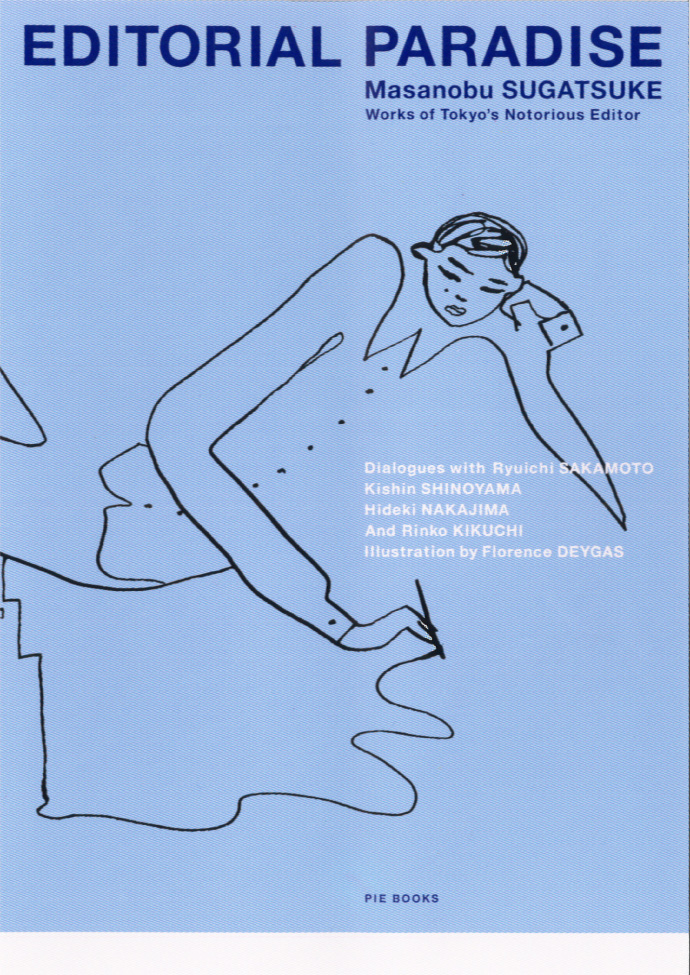
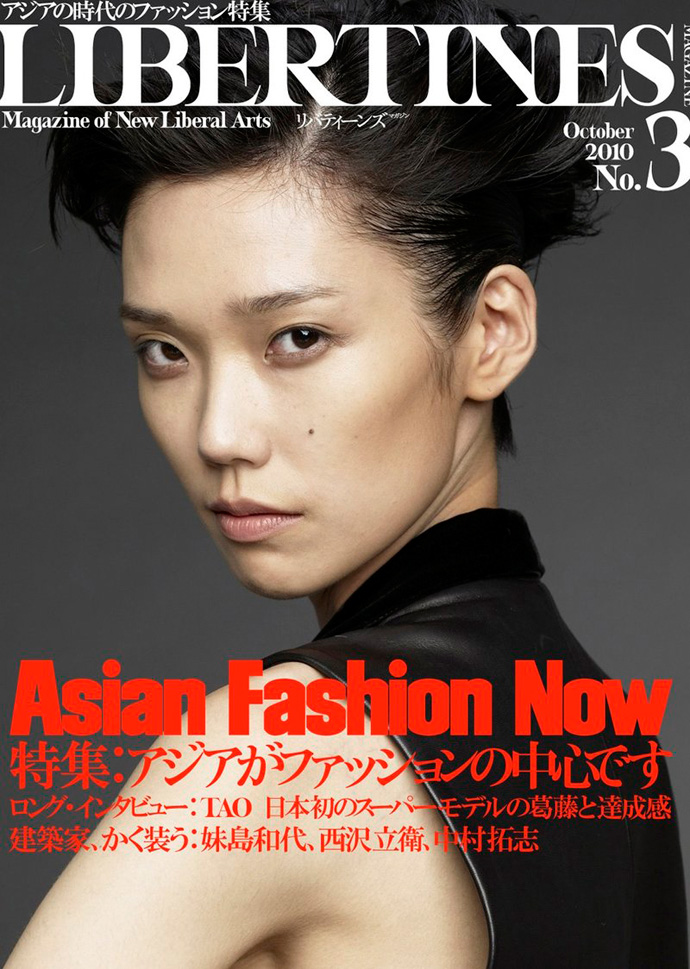 Sleeve of EDITORIAL PARADISE with an illustration of Masanobu Sugatsuke by Florence Deygas and a recent LIBERTINES cover
Sleeve of EDITORIAL PARADISE with an illustration of Masanobu Sugatsuke by Florence Deygas and a recent LIBERTINES coverIt’s something rare in this profession to put a focus on the act of editing itself, especially one’s own and in such a radical way as with your latest book.
As you can see, editors have been defined as interpreting someone to someone else, or something to something else. That means “Don’t express your own voice through your works. You are an in-between guy!”.
That’s 50% right. But there are so many high-profile advertising creative people all over the world. They are not behind the media at all nowadays.I believe editors are mainly present in-between and behind media, but sometimes they are beyond media, i.e, Anna Wintour, who is Cabinet Minister of the Ministry of Cool, Terry Jones, Everlasting Evangelist of Street Style and Olivier Zahm, the second Gainsbourg.
I believe we, creative people, have to label ourselves. In other words, we have to “transform life into creation”.
Because, in this 21st Century, our creative lives are almost viewed and leaked by web and twitter.
It’s been getting hard for creative people to avoid being watched or criticized by ordinary people now.Iconic editors from the past seem in this context like vanguards of another time to come:
Diane Vreeland (American Vogue) or, on another side of the spectrum, Hugh Heffner (Playboy), both transcended their editorial vision with their personal lives.Today’s ever more fragmented stream of information requests perhaps a stronger necessity of structure through the personal standpoint…
How do you think the element of today’s over-exposure is influencing the role of the editor?
Over-exposure is big phenomena in our world, not just for editors. Modern people are fame-addicted.
On the other hand, we can show our way of living as an art piece. Lady Gaga’s case is the most excessive one, and Haruki Murakami’s case is the most stoic.
But both are most successful presentations of life as art piece today.As I said, our creative lives are mostly viewed, watched by the media and each action are “timeline”d.
So if you can’t avoid it, you have to be determined to show your life as whole art piece, as if Andy Warhol presented us.
So, Warhol said “Everyone will be famous for 15 minutes” in the 60’s.
But now everybody became Andy Warhol, just like taking photo everyday, quoting somebody’s ideas and images and commenting as one phrase philosopher on twitter or blogs.Our creative works are slices of our creative lives. People nowadays have a tendency to prefer the real lives of creative people to their work.
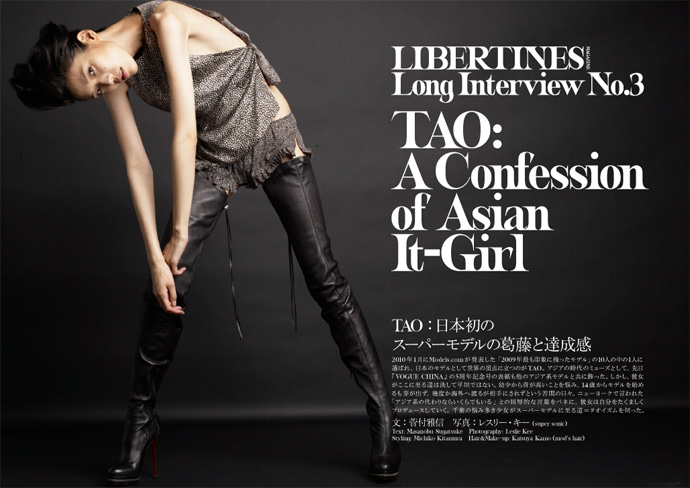 Spread of "AISIAN FASHION NOW" from a recent issue of LIBERTINES. Photo by Leslie Kee
Spread of "AISIAN FASHION NOW" from a recent issue of LIBERTINES. Photo by Leslie KeeIn these times, the stream of facebook statuses, tweets and re-tweets, tumblr and so on form a new way of consuming information.
You recently mentioned Paper.li to me – which seems like an attempt to “master” this stream almost a form of an “automatic generating editor”….Yes, “Paper.li” is a kind of semi-auto-updated personal web magazine. On the web, if you curate something, you can be an cool editor. Therefore “first hand” is getting more important for media and creative people. Audiences can’t get interviews of celebrities and take their photo first hand.
So, “first hand” sources and high profile people are the last sanctuary of professional media and creative people.
But if they are lazy to maintain “first hand” capability, audiences will rob it.The internet is certainly a big accelerator of this “theft”!
What we’re missing out besides “first hand” is the synthesis of information and its digestive analysis.
I am wondering how do you expect the print media to react to this and how you see its perspectives in the long run, in balance with the digital publishing?I expect that print media will live with digital media in symbiosis. I believe print media will survive, as opera and theatre play do.
But not mainstream in the media.
There are two kind of information, flow and stock.
Internet is a best media of flow information. Print media is a best of stock information.
For creative people, beautiful books must be great tangible assets.
In this 21st Century, tangibility and physical experience can be more important because internet cannot provide them.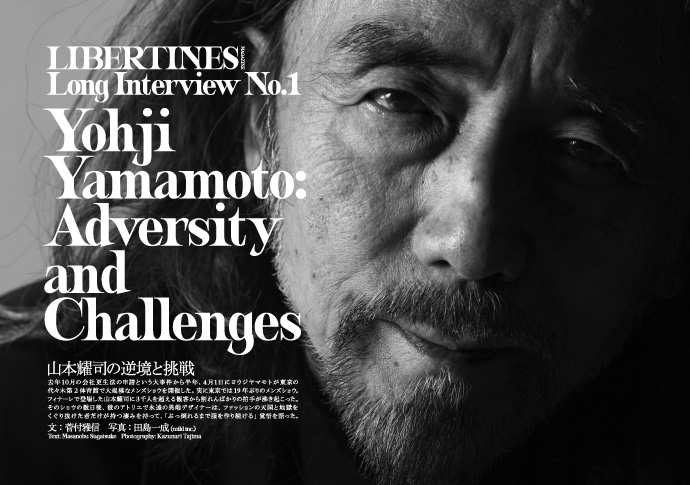 Opener of the Yohji Yamamoto Interview of LIBERTINES
Opener of the Yohji Yamamoto Interview of LIBERTINESYou have recently halted publishing your most recent print magazine “libertines”-
what was your experience with this? Were the reasons related to the shift in publishing that we’re talking about?Talking about the end of “Libertines” magazine, I think I was a little bit too optimistic about the advertising climate and today’s readers. It was my fault.
Advertising for magazine has been drastically decreasing. I knew it. But I had estimated that I could have get a certain amount of it when I started “Libertines”.
But I couldn’t. It was worst time to start a new magazine in Tokyo with a professional level of budget.Plus, I thought we could get a number of readers similar to what we had before. So, for the first issue of “Libertines”, we had a special feature about twitter culture.
We had exclusive report about twitter headquarters in San Francisco in it.
As you can imagine, we got big buzz on twitter and web when it came out.
BUT this buzz were not enough to sell magazine.It is a similar situation for musicians and the web. If some musicians get big buzz on twitter and facebook, but their record sales are not related with buzz unfortunately these days.
It happens in magazine world.I think “buying magazines” has become an old habit, or habit for people over 30’s.
If you aim to produce youth culture-medias and package contents, there are few actual youth consumers who buy them naturally.On the other hand, I’ve been directing another magazine “Metro Min.” for two years as creative director, it is quite successful because it’s a monthly free lifestyle magazine which is published by a major publisher.
So, it is hard to sell magazine to the FREE generation. I’ve been struggling with this issue.
I don’t have a clear solution for it. But I’m not pessimistic about the future of magazines. I think publishers and editors have to organize a new kind of structure to make profit not only to produce print medias.I believe there are great examples in the movie industry. The movie industry is not just about movie theatre nowadays as you know. It is an environment with movies.
I think that’s the hint for editors.

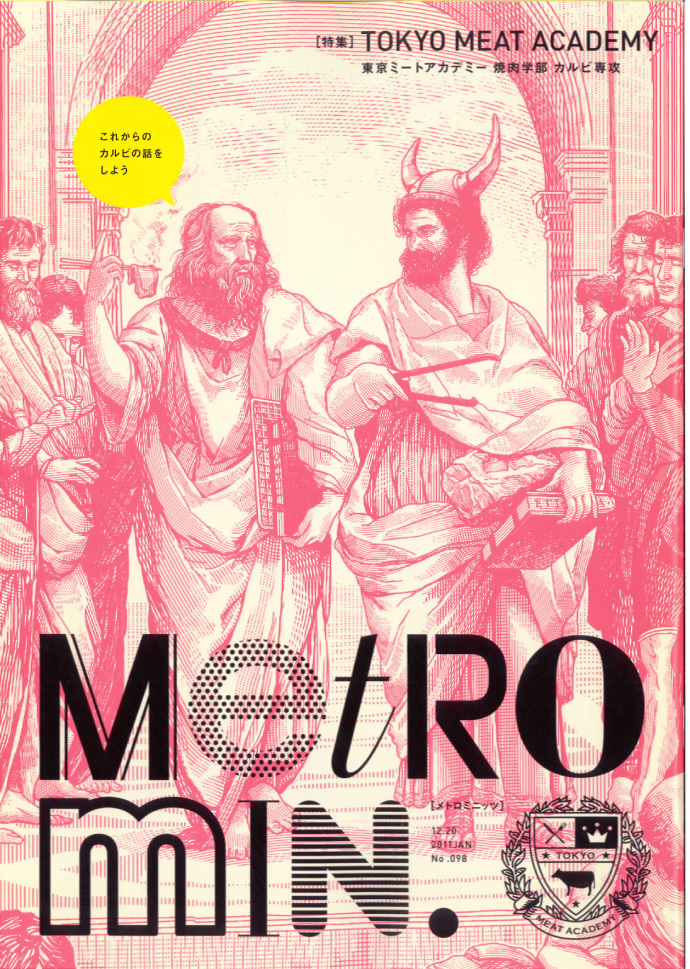 Covers of METRO MIN, the most recent publication of Masanobu Sugatsuke
Covers of METRO MIN, the most recent publication of Masanobu SugatsukeWhere do you see the future?
I’ve been thinking about the fate of both print media and new media all the time as I mentioned in our previous conversations.
And as you see, nobody knows. But there is one certain thing that I can say, that is if you love something, you’d like to own and touch it.
Same as your lover. That’s the human nature which will not change forever.People nowadays talk mainly figures and speed of modern media. But media are not only produced by them. Of course, these specs are important.
But images, sympathies, affections and favoritism are very important elements of media.
If these elements are all included in one media, then it will be a loved media no matter if it’s in the form of digital or print.I believe that creative people have to concentrate on how to produce a loved media to audiences. I think that’s the priority.
The last thing stimulated that stimulated you?
So many things and it is hard to answer to choose one particular thing.
Here is the list what I was stimulated after 3.11, the Great Earthquake in Japan.# Cindy Lauper concert in Tokyo on March 17th, just 6 days after Earthquake.
Cindy is a quite brave artist who did Japan tour in such a catastrophic situation and she commented during each break between songs to encourage audience in Japan.
She sang her masterpiece “True Colors” in encore with mix of John Lennon’s “Power to the people” and almost the whole audience, including me, wept.# Takashi Homma photo exhibition at Tokyo Opera City Gallery in April
Homma’s biggest exhibition in Tokyo which shows his conceptual landscape in Japan and Los Angels which was collaborated with Mike Mills.# Jane Birkin Charity live at Shibuya Club Quattro, April 6th
Jane Birkin is not just an actress or singer. She is a role model of modern women.# Anti-Nuclear Demonstration in Koenji, Tokyo, April 10th
Most biggest and joyful anti-nuke action in Japanese history. So many musicians joined it and I participated in it. People have the power!# Saburo Teshigawara dance performance at Kawasaki City art center, May 6th
It is a final answer to the question “How can movement of human body be radical and beautiful”. Teshigawara does European Tour this Autumn. Must-See!# Henry Darger exhibition at Laforet Museum Harajuku, Tokyo, May
Legendary outsider artist’s big retrospective. So innocent and scary.# Yohji Yamamoto’s 30th anniversary party of his brand at Y.Y boutique in Tokyo, June 1st
Yamamoto is a last samurai of cutting edgy couturier. Congratulation!
-

SAVE TOKYO CREATION
-This week, under the helm of curator Takafumi Kawasaki, 18 hot Japanese fashion brands and 10 photographers team up in Tokyo for SAVE TOKYO CREATION. As the official Tokyo fashion week was cancelled due to the recent events, stylist Takafumi Kawasaki initiated this show to give young designers an opportunity showing their collections from May 27th to 29th at EYE OF GYRE, Omotesando, Tokyo. Accompanying the show, artworks by Tokyo Posse ENLIGHTMENT will be on display, and a fanzine produced.
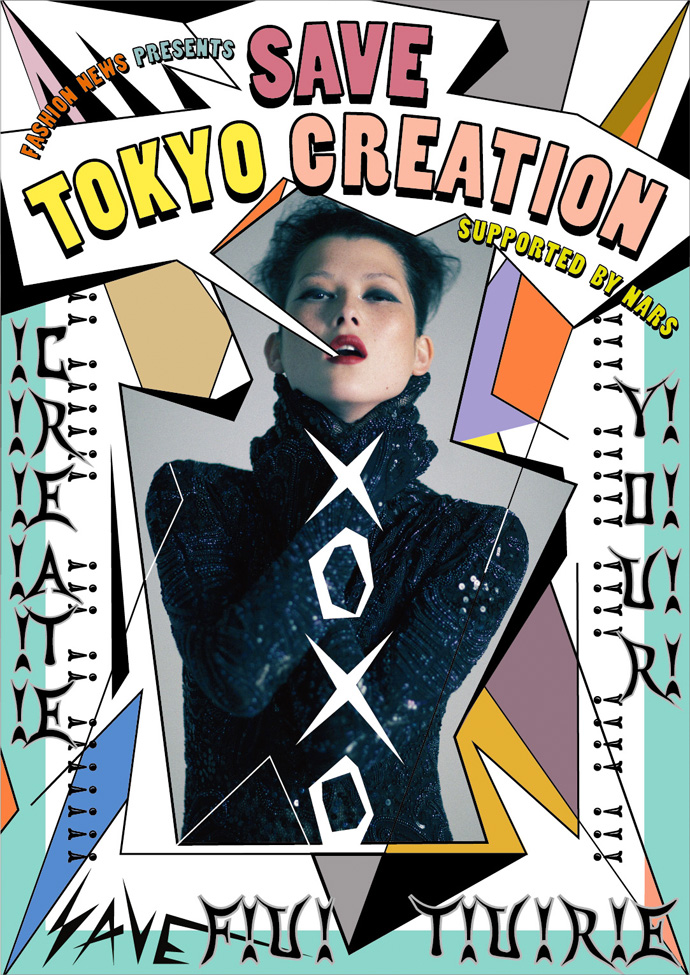
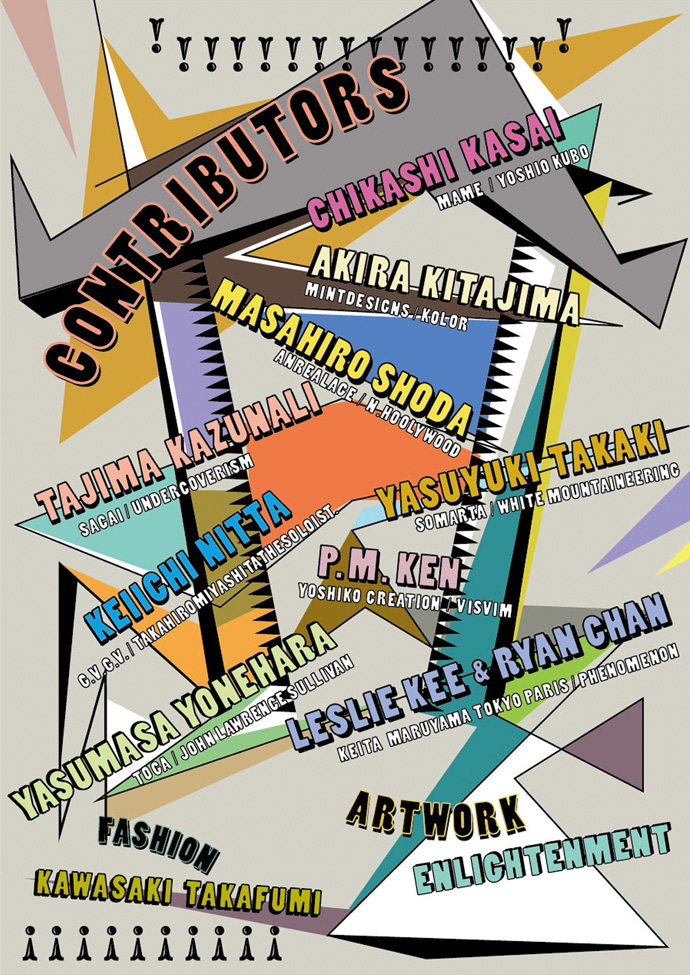 Poster of SAVE TOKYO CREATION by ENLIGHTMENT. Photography by Yasuyuki Takaki
Poster of SAVE TOKYO CREATION by ENLIGHTMENT. Photography by Yasuyuki TakakiThe 18 designers produced special pieces for the project to be auctioned for donation. Among the designers showing, is much beloved Jun Takahashi for UNDERCOVER, YOSHIKO CREATION, famous for her unique pieces to Lady Gaga, TOGA, N.HOOLYWOOD and emerging designer JOHN LAWRENCE SULLIVAN, among others as ANREALAGE, G.V.G.V., KEITA MARUYAMA TOKYO PARIS, MAME, MINTDESIGNS, SACAI, SOMARTA, KOLOR, PHENOMENON, TAKAHIROMIYASHITATHESOLOIST, ISVIM, WHITE MOUNTAINEERING and YOSHIO KUBO.
 SAVE TOKYO CREATION Photography by Keiichi Nitta
SAVE TOKYO CREATION Photography by Keiichi NittaThe designers AW 2010 designs were picked up by Photographers and lensed especially for that show: Akira Kitajima, Chikashi Kasai, Tajima Kazunali, Keiichi Nitta, Leslie Kee & Ryan Chan, Masahiro Shoda, By P.M. Ken, Yasumasa Yonehara and Yasuyuki Takaki.
The Stimuleye spoke with Takafumi Kawasaki
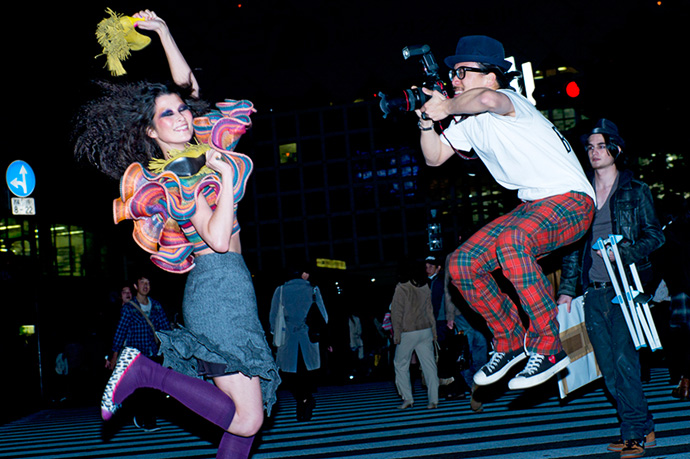 SAVE TOKYO CREATION Photography by Leslie Kee & Ryan Chan
SAVE TOKYO CREATION Photography by Leslie Kee & Ryan ChanRENÉ HABERMACHER: What was your intention with this exhibit?
TAKAFUMI KAWASAKI: SAVE TOKYO CREATION supported by NARS is a big feature of Japanese fashion designers, most of whom lost a chance to exhibit their 2011AW collection because of the earthquake impact.
It’s a charity but not a money-donated oriented.
I wanted to provide Japanese fashion designers a chance to show their 2011AW collection that could not be shown on catwalk because of the earthquake.
As a fashion director & stylist, I believe it is a form of charity that only I can produce to provide those designers with the opportunity to present their creation in public.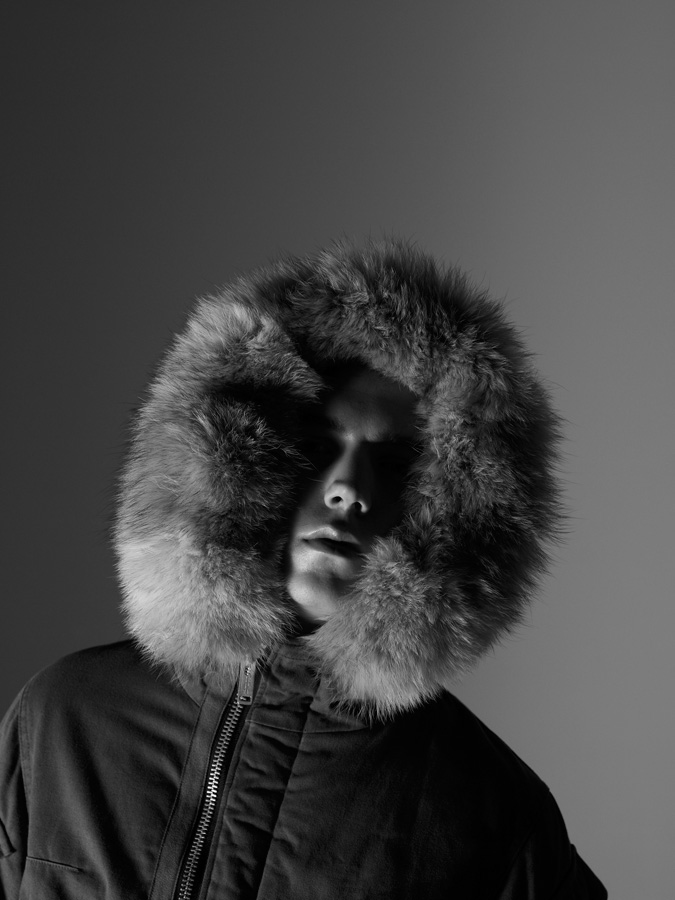
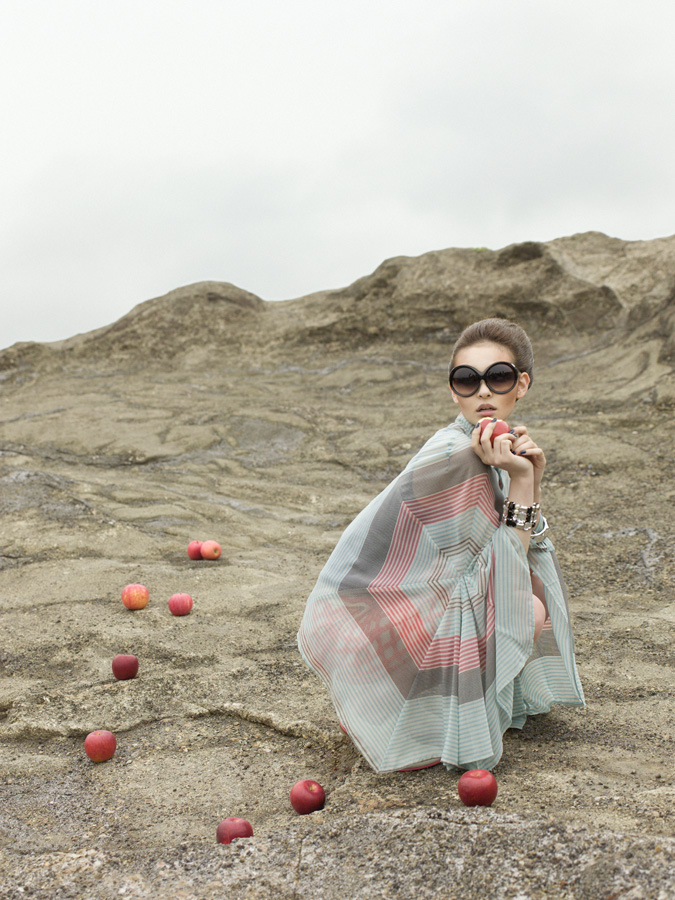 SAVE TOKYO CREATION Left: Photography by Kazunali Tajima. Right: Akira Kitajimat
SAVE TOKYO CREATION Left: Photography by Kazunali Tajima. Right: Akira KitajimatHow did the earthquake and its aftermath affect you personally?
The earthquake made me find the huge scepticism about Japanese government and the power of citizens. I would say I feel my approach to fashion and my styling works became more clearer and straight forward.
It may sound a little funny but I became more optimistic about the life. What already happened, happened, even if it’s a massive tragedy, there is no way to change or dismiss it. I feel there is no point to keep crying over that. But what we should do now, is to step forward.
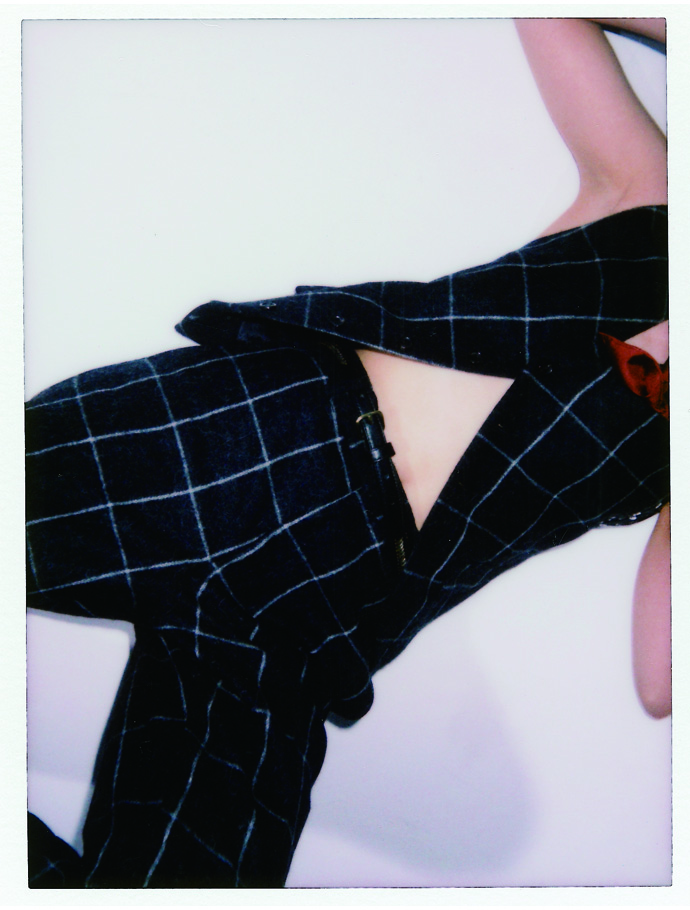
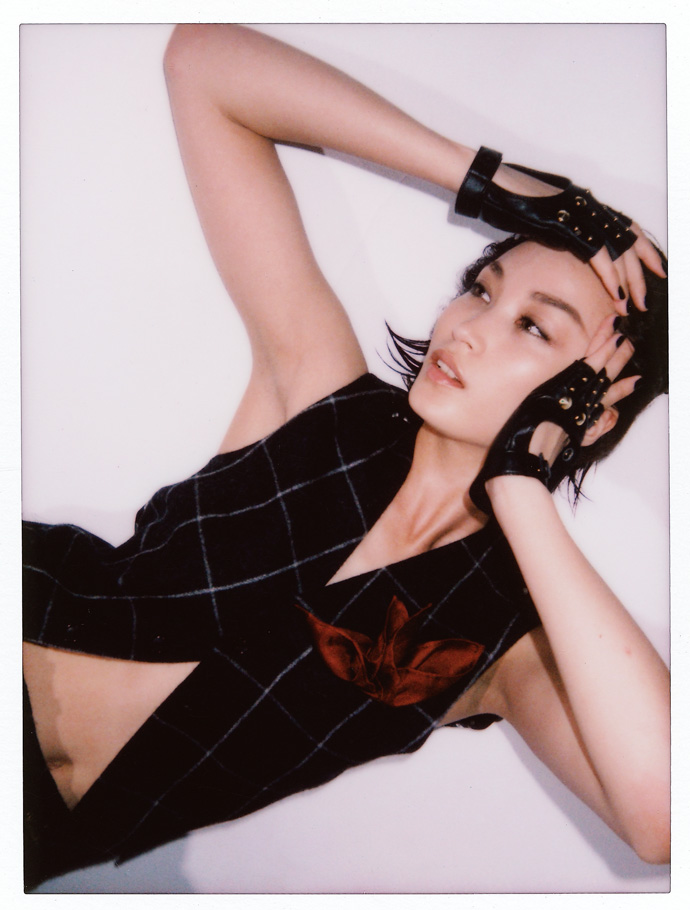 SAVE TOKYO CREATION Photography by Yasumasa Yonehara
SAVE TOKYO CREATION Photography by Yasumasa YoneharaDo you feel there is a different mood now among japanese society? I am asking as Japanese people expressing in the past to feeling alienated to their fellow countrymen…
Yes, “alienation” is a serious issue after the quake. Japanese people appear to be longing for the tightly-bound feeling.
Not only real communication and society, but also they are keen to make bonds with others in virtual community, such as Facebook, Twitter and other numerous social media networks. Some people are obsessed about that too much.Generally speaking, however, I think the Japanese people have found what is important and what is less in life. I believe this is a great chance to reform the typical Japanese convenience-oriented life.They appear to have started making their lives a little slower and calmer, too.
It’s really a big shift of the country.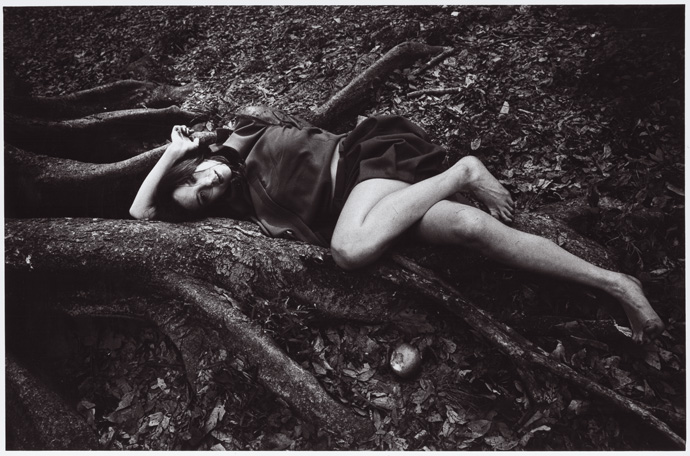 SAVE TOKYO CREATION Photography by Chikashi Kasai
SAVE TOKYO CREATION Photography by Chikashi KasaiWhat is the last thing that stimulated you?
I would say THE EARTHQUAKE in Japan.The exhibition is held from May 27th to 29th at EYE OF GYRE, Omotesando, Tokyo.
 SAVE TOKYO CREATION Photography by Masahiro Shoda
SAVE TOKYO CREATION Photography by Masahiro Shoda -

What will you do for the summer holidays?
-What will you do for the summer holidays? This is a question we here often these days, a perfect conversation piece celebrated from Athens to Paris, London to New York. As a result of this planning many cities will be left deserted at the peak of August. So where do we go?
Travelling, the outlook to discover new and exotic places are something that stimulates us and we look forwards to.
How we could have left that out at The Stimuleye? I don’t know, it’s almost a crime!So we decided to start another series of special places that inspire and enlighten in one or another way. Off track, from a beach bar on a secluded island in Kenya to a spooky ryokan in Japan. And we’ll include food in addition that seems an important part of this experience. Specially considering that Stimuleye Antoine Asseraf had ran a blog around food: FOODGEEK, one of the godparents to The Stimuleye. That might all sound very TAMPOPO – and yes that’s exactly where we’re going with this.
So learn about the addresses for the best Japanese rahmen noodles or Mexican bull-meat tacos, Greek homemade pies, hefty Cuban mojitos or the perfect ring formed bread that’s handed out hung on thread to hold it best, since it’s hot and oven-fresh!
You might stay home during the summer, but nevertheless and hopefully, one of the places we’ll cover in this series starting from tomorrow, will be near you to discover. If you have a tip you believe should be shared and not left out, let us know!
Scene from alltime ultimate Japanese foodgeek movie TAMPOPO. Directed by Jûzô Itami, 1985
-

rising hope
-For days we have watched in awe the dramatic events unfolding in Japan, following the news that show big parts of that highly sophisticated and industrialised country laying in scatters what looks like aftermath of a war, one cannot but be impressed by the calm and altruistic spirit of the people reacting to this tragedy.
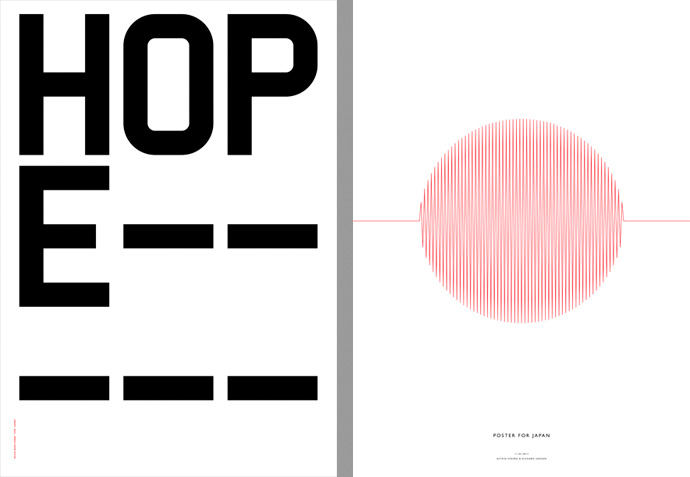 WORD POWER [JAPAN] by Build and POSTER FOR JAPAN by Astrid Stavro & Richard Sarson
WORD POWER [JAPAN] by Build and POSTER FOR JAPAN by Astrid Stavro & Richard SarsonPerhaps even more impressive than Japan’s technological power is its social strength:
Supermarkets cut prices, vending machine owners giving out free drinks and restaurant owners handing out free food as people work together to survive.
Nippon, that seemed in “hyber-nation” for the last decades of economic decline, with its population alienated and facing a lethargic new generation is putting an incredible collective solidarity on display. We can only guess what impact this catastrophe will leave on the collective consciousness of the japanese in the long run. As Japanese writer Ryu Murakami puts it in The New York Times:
“Ten years ago I wrote a novel in which a middle-school student, delivering a speech before Parliament, says: “This country has everything. You can find whatever you want here. The only thing you can’t find is hope.”
One might say the opposite today: evacuation centers are facing serious shortages of food, water and medicine; there are shortages of goods and power in the Tokyo area as well. Our way of life is threatened, and the government and utility companies have not responded adequately.
But for all we’ve lost, hope is in fact one thing we Japanese have regained. The great earthquake and tsunami have robbed us of many lives and resources. But we who were so intoxicated with our own prosperity have once again planted the seed of hope. So I choose to believe.”
(NYT of March 16, translated from Japanese by by Ralph F. McCarthy)
The altruistic spirit people encounter these days in Japan on their road to recovery manifest itself in a myriad of small stories. Inspired by this, Jun Shiomitsu, student at University of Cambridge created a blog “Voices from Japan” together with ten of his classmates and friends, sharing tweets from japanese twitter accounts. Some of these short messages, proof on personal experiences, we would like to share with you following. For more please see “Voices from Japan”.
This article is illustrated with posters from Designers for Japan, a collaborative bringing designers and imagemakers together to aid relief efforts “and to express our love and respect for our friends in Japan”.The poster sales profit will go directly to The Red Cross and Shelterbox.Direct donations for Japan can also be made at: Red Cross Japan
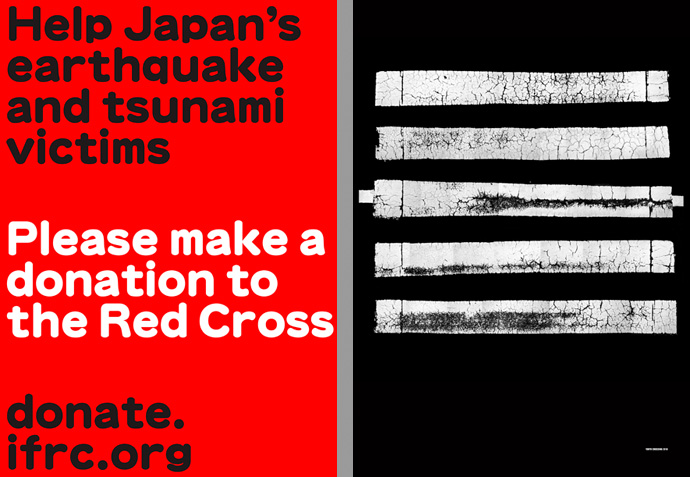 DONATE... by Practice and TOKYO CROSSINGS by Fabian Monheim
DONATE... by Practice and TOKYO CROSSINGS by Fabian MonheimThis earthquake has reminded me of that Japanese goodness that had recently become harder and harder to see. Today I see no crime or looting: I am reminded once again of the good Japanese spirit of helping one another, of propriety, and of gentleness. I had recently begun to regard my modern countrymen as cold people … but this earthquake has revived and given back to all of us the spirit of “kizuna” (bond, trust, sharing, the human connection). I am very touched. I am brought to tears.
(Original Japanese text) * 日本人の良さを再認識
この地震が、きっかけになって、失いかけていた日本人本来の良さが戒間見れた気がする。犯罪はする様子はなく、助け合い、律儀、紳士的。普段日本人は冷たい人が多い…。って個人的に感じてるんだけど、多くの人が今回で「絆」を取り戻しつつあるように見えて、それがなんか感動して、泣けてくる。
— アジアの架け橋 Suzuki Viet (@VietL) March 12, 2011
この地震が、きっかけになって、失いかけていた日本人本来の良さが戒間見れた気がする。犯罪はする様子はなく、助け合い、律儀、紳士的。普段日本人は冷たい人が多い…。って個人的に感じてるんだけど、多くの人が今回で「絆」を取り戻しつつあるように見えて、それがなんか感動して、泣けてくる。
My Boyfriend, Off with His Rescue Unit
Yesterday, I said goodbye to my loved one as he left for one of the hardest-hit areas, Minami Sanriku in Miyagi. He is a member of the Fire Department’s special rescue unit. As I bade him goodbye, I asked “Are you scared?” He simply answered “I just feel sorry for those people whose bodies are still buried and cold and lonely. I just want to help find their bodies as soon as possible so that they can be returned to their families.” This from my boyfriend who is normally so shy he can’t go shopping for clothes by himself. Seeing his quiet resolve, I stifled my tears and sent him off with a smile.
(Original Japanese Text)
http://twitter.com/_amurita_/status/51489294690426880
昨日、私の大切な人が南三陸沖へ出動しました。彼はハイパーレスキュー。「怖い?」と聞いたら「埋まって亡くなられた方が寒いのが、可哀想なだけ。早く出して家族の元へ還したいだけ」と。休日1人で服も買いに行けないシャイな彼が。私も泣かずに送り出しました。
Through the Eyes of a Child
A small child was waiting in line to buy some candy. As his turn approached, I saw him look intently at the cash register for a moment, deep in thought. He then trotted to the disaster relief donations box on the counter, dropped his few coins into it, and trotted back to the shelves to return the candies that were in his hand. As the employee called after the boy thanking him saying “arigato gozaimasu!”, I heard her voice tremble with emotion.
(Original Japanese Text)
Twitter / 松元恵: 子供がお菓子を持ってレジに並んでいたけれど、順番が近 …
http://twitter.com/#!/matsugen/status/47231589758935040
子供がお菓子を持ってレジに並んでいたけれど、順番が近くなり、レジを見て考え込み、レジ横にあった募金箱にお金を入れて、お菓 子を棚に戻して出て行きました。店員さんがその子供の背中に向け てかけた、ありがとうございます、という声が震えてました。
